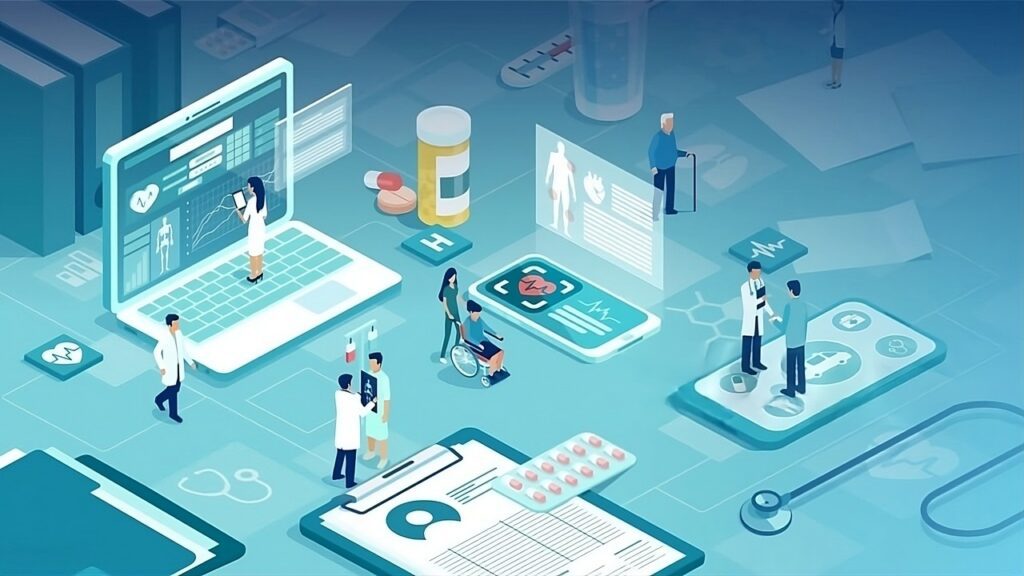
EMR development is the process of making a digital system that doctors and nurses use to keep track of patient information electronically. Unlike regular paper files, electronic medical records (EMRs) let you access medical records in a safe and quick way.
The goal isn’t only to turn paper charts into digital ones; it’s to make care better. With EMR technology, doctors can make better decisions, get more accurate diagnoses and help patients get better. They make things easier and are very important for bringing healthcare up to date.
For hospitals and clinics, a strong EMR system means smoother workflows, fewer mistakes, and better teamwork among healthcare workers.
So, how do you make one? Let’s look at the most important steps and parts that go into making a good EMR.
Table of Contents
ToggleWhy EMR Development is Crucial for Healthcare Providers
In today’s healthcare world, efficiency, compliance and accuracy are not up for debate.
This is when EMR development really shines.
An EMR system gives you:
- Better treatment for patients: Doctors can make decisions based on data more quickly when they can see a patient’s medical history, lab results and medications right away.
- Efficiency in operations: It cuts down on repetitious paperwork and speeds up administrative chores, which cuts down on mistakes and delays.
- Better talking to each other: EMRs make it easy to share data between departments and facilities, making sure that every physician has the correct information at the right time.
- Security and compliance: A compliant EMR technology meets regulatory requirements including HIPAA, which protects the privacy and accuracy of patient data.
As healthcare grows more data-heavy, using EMR systems isn’t an option; it’s a smart way to increase both care quality and return on investment.
Different types of EMR systems and what they can do
There are many types of EMR systems to choose from because not all healthcare providers have the same needs. Knowing the differences between each type will help you find the right one for your clinical needs and budget.
| EMR System Type | Description |
| Standalone EMR | Ideal for solo practitioners or small clinics. Provides essential functions without integrations. |
| Integrated EMR | Connects to billing, scheduling, labs and more. Suitable for medium to large practices. |
| Cloud-Based EMR | Offers remote access and scalability. Stores data securely on external servers. |
Choosing the correct EMR model influences more than just how easy it is to use; it also affects how much it costs, how well it can grow and how well it controls data.
These types of EMR systems come in different sizes and have different functions. Integrated or cloud-based platforms are usually better for bigger hospitals, while private clinics may only need standalone systems.
Important Parts of an EMR Development Project
When you plan your EMR development process, there are several elements that you can’t change if you want it to be usable and compliant.
These features affect how many people use the system, how accurate the data is and how well it works.
Here are the most important things:
1. Full management of patient records
Put everything from your medical history to your current prescriptions in one place.
2. Easy to Use Interface
Doctors and nurses don’t have time to figure out complicated systems. The user interface needs to be simple and easy to use.
3. Advanced security protocols
To keep sensitive data safe, the EMR must be closed using things like role-based access and two-factor authentication.
4. Working together
A big time-saver is being able to easily connect with lab systems, pharmacy tools and insurance APIs.
5. Reporting and Analytics
Tracking is equally as important as treatment in healthcare. Use built-in analytics to find patterns and make patients better.
According to industry standards, EMR systems with built-in reporting tools can make following up with patients up to 30% more efficient.
Each of these parts helps things run more smoothly and makes it easier to make clinical decisions.
Steps for EMR Development: Planning, Building and Using
Step 1: Figure out what your system needs
Planning that is clear and explicit is the first step in every successful EMR development project.
Before you start writing any code, you need to define the following:
- Who will utilize the system? Is it for a small outpatient clinic or a large hospital with several specialties?
- Important features: Does your EMR need to provide billing, scheduling or patient portals?
- Compliance needs: What rules do you have to follow in your area or around the world (for example, GDPR or HIPAA)?
- What you expect from security: How much data protection do you need for your use case?
- The more clearly you specify your system at this point, the fewer problems you’ll have while developing it. Get real healthcare providers involved at this point. When deciding what to focus on first, their feedback is important.
EXAMPLE: A dermatology clinic could need a picture repository built into the patient profile area, whereas a dental clinic might put more emphasis on tools for arranging treatments and keeping track of appointments.
Step 2: Choose the Right EMR Tech Stack
The long-term performance of your system depends on the EMR tech you choose.
Here are some choices you will have to make:
| Tech Element | Recommended Options |
| Frontend | React, Angular, Vue.js |
| Backend | Node.js, Django, Ruby on Rails |
| Database | MySQL, PostgreSQL, MongoDB |
| Hosting | AWS, Google Cloud, Microsoft Azure |
| Security Features | SSL, AES Encryption, OAuth 2.0 |
Choose technologies that can grow with your business, have good documentation and follow healthcare industry norms.
The correct EMR tech makes sure that your app can grow, is stable and is safe.
Step 3: Look for the Right EMR Developer
The people that develop your system are what make it good. That’s why it’s so important to choose the proper EMR developer or team.
Look for developers who:
- Have worked on healthcare projects before
- Know about healthcare procedures and data protection rules
- Can connect third-party APIs and tools (such pharmacy and billing)
- Are okay with scaling and maintaining a product over time
If you’re hiring freelancers or a development agency, be sure they have the right credentials and examples of their work.
EMR systems made by teams that are experts in a certain field have 40% fewer delays during implementation than those made by generalist developers.
A good EMR developer will make sure that your platform is fast, dependable and serves the demands of both patients and providers.
Step 4: Start building and putting the system together
After the base is set, work on the project can start. At this point, your team should operate in sprints, which means splitting up the work into smaller, more manageable parts.
Concentrate on creating:
- Modules for patient records
- Dashboards for administrators
- Interfaces for scheduling
- Pipelines for connecting labs and pharmacies
Make sure to use the types of EMR systems structure you chose previously whether it’s cloud-based, integrated or standard-alone. That design will tell you how to develop everything else.
When connected directly to diagnostic and imaging instruments, integrated EMR systems can make workflows 25–30% more efficient.
Your development team should also make sure that they test everything thoroughly at every stage, from unit tests to security audits.
Step 5: Testing, Deployment and Maintenance
If you don’t test it properly, even the best-designed EMR system can fail.
Before going live, you should think about the following:
- Functionality: All functionalities, including entering, retrieving and syncing data, should work all the time.
- Security: Data must be encrypted both when it is being sent and when it is not.
- Usability: Medical professionals should be able to do their daily responsibilities with as few clicks as possible.
- Speed and performance: The system needs to load rapidly, even when there is a lot of traffic.
After deployment, it is very important to keep up with maintenance. Your EMR’s life can be extended by fixing bugs, adding new features and regularly applying security patches.
Ongoing support isn’t only about correcting issues; it’s also about adjusting to new healthcare rules, user input and changing business needs.
How to Keep Your EMR System Running for a Long Time
After deployment, EMR development doesn’t end. It needs regular updates and maintenance, just like any other strong software system. This involves making security processes better, making things work better and keeping up with changes in healthcare laws.
The healthcare sector is moving quickly. New rules, new technologies or new problems with running a business may cause the types of EMR systems you see today to change.
Keeping your system up to date with industry developments will help you stay competitive and follow the rules.
You should also get your users involved. Getting input from doctors, nurses and administrative personnel on a regular basis can help you understand how well the system works for them in their daily tasks. Their feedback helps your EMR developer add features that make the program easier to use and speed up typical tasks.
Keep in mind that maintenance isn’t simply about stopping problems. It’s about always making your investment worth more, whether that’s by getting better analytics, quicker access to records or features that save you money. A well-maintained EMR helps maximize ROI over time by increasing productivity and lowering administrative costs.
Final Thoughts
Writing code is only one part of making a good EMR system. It takes careful preparation, working with healthcare professionals and a long-term plan for growth and compliance.
Begin by making sure you know what you need.
Pick the best EMR tech stack that works with your infrastructure and lets you grow.
Find a qualified EMR developer who knows how to keep data safe and follow healthcare rules. These first choices set the stage for a safe and useful answer.
As you design and put the system into operation, pay attention to how users interact with it.
A fast, safe, and easy-to-use EMR software lets medical professionals spend less time on screens and more time with patients. This means that procedures go more smoothly and clinical results are better.
Don’t think of your EMR as “done” once it’s live. To keep it in line with your organization’s aims, you need to keep it up to date and make improvements to the system all the time.
Smart EMR development can change how you give treatment and how well you run your business, whether you run a tiny clinic or a huge network of hospitals. You can improve how healthcare works by investing in software the correct way.


